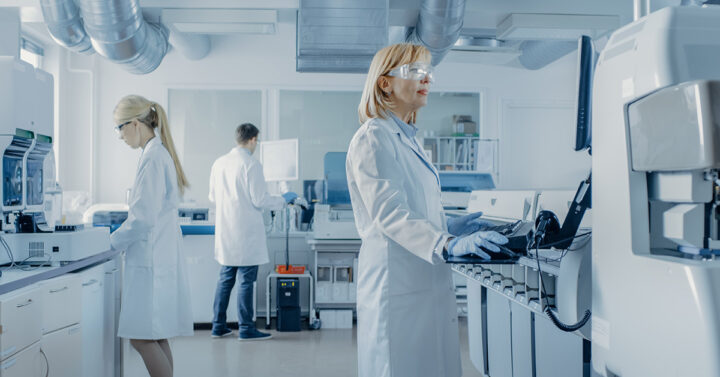6 Time-Saving, Tech-Driven Methods for Speeding up Drug Development

The ultimate goal in pharmaceutical development is to go from the preclinical phase to clinical trials as efficiently as possible. Biotech co-founders and leadership teams are looking to keep up with competitors, while working on timelines that have been rewritten and accelerated by the COVID-19 vaccine breakthroughs.
Leadership teams also have to consider cost-efficiency, industry trends, the rising costs and unpredictable availability of lab supplies,and available technologies when planning out their drug development processes.
Fortunately, industry advancements are changing the way biotech enterprises research and develop drugs that save labs time and money, while improving safety and precision. Some of these techniques involve assessing and revamping current methods for patient recruitment, drug development, or site performance, making them cost-effective and more inclusive to wider patient populations.
Here are six ways that biotechs can speed up the drug development process using more efficient lab operations and R&D workflows.
1. Automate Development Stages
Many large pharmaceutical companies continue to use clinical trial processes dating back to the 90s, and aren’t able to keep up with the emergence of new data sources and innovations. The data processing projects appear insurmountable, and new information comes in before existing research has been reviewed. The solution? Automating development stages of clinical trials.
Automation offers increased efficiency among team workflows, reduces the amount of hands-on time for repetitive tasks, and decreases the chance for human interference or error when handling data. It has the potential to enhance trial productivity in later stages, tighten up patient recruitment processes, and analyze data collected.
For biotechnology companies looking to implement automation, time is of the essence. Digital transformations in the lab can be a laborious undertaking that requires time, as well as a shift in the overall systems versus individual projects. It also requires more than a “set it and forget it” mentality — consistent checking and iteration of automated processes helps ensure systems are operating properly. Done right, though, the payoff is enormous — time spent now is time saved later, and more automated processes means more capacity for new projects.
2. Implement Artificial Intelligence
Artificial intelligence (AI) in healthcare is on the rise, as many organizations look to adopt machine learning and other AI-driven methods. These efforts are aimed at reducing time spent researching and developing new drugs by eliminating the hours and funding typically dedicated to bench scientists manually processing data.
Traditional stages of early research, once taking four to six years to complete,now have shortened discovery timelines thanks in part to artificial intelligence. It also simplifies once arduous patient recruitment stages when researching new drugs.
In a 2019 study, researchers from the Research Center of the Sainte-Justine University Hospital, used advanced bioinformatic analysis to determine potential clinical responses in the early stages of drug discovery. This allows for researchers to predict potential drug implications on recruited patients, before starting clinical trials.
3. Assess Current R&D Site Performance
Pharmaceutical companies can audit existing site performances by utilizing available data sets, both internal and external. When data is plugged into predictive machine-learning algorithms, leadership teams are able to shift and realign company goals with existing sites to get back on track.
Alternatively, they can revamp existing sites using incoming or existing patient data. In the United Kingdom, the National Health Service surveyed patients’ conditions using a pre-established hotline, directing them to appropriate hospitals to treat said conditions.
Patient data collected from the phone line helped direct hospital leadership teams when working to establish future locations for clinical trial phases and research sites.
4. Enhance Patient Trial Experience through Tech
Even prior to the pandemic, digital health equipment was already quite prevalent within pharma tech, as a means of patient recruitment and participation in trials with low engagement.
Despite best attempts by the pharmaceutical industry to blend existing trial stages with new patient technologies, the pay-off is less effective than when implemented from the start. Enhancing patient trial experiences with equipment and tech, like e-consent and patient engagement apps, are best implemented in the beginning of a new trial process, rather than halfway through.
Additionally, biotech leaders can incorporate seamless operation strategies for lab staff throughout patient trials, using remote collaboration software. Employees are able to access confidential patient documents via secure cloud storage from both home and work, at any stage of the drug trial, preventing delays.
5. Participate in Cross-Industry Collaboration
Taking advantage of cross-industry collaborations and partnerships, serves as another great starting point for reducing time frames during drug development.
Biopharma companies can improve the patient experience during clinical trials by taking a page from the consumer-facing world. With healthcare tech like apps that show lab results, the experience is smoother for both the lab and the patient.
Additionally, through collaborations with data professionals, like data scientists and machine learning engineers, biotech experts can improve their own data sets and storage processes, and develop techniques for enhanced analysis of existing drug data.
Co-founders should also consider joining biotech incubators and accelerators. Providing ample opportunity for lab staff and scientists to learn, collaborate and foster professional relationships, incubators are a fantastic resource for project development, and exploring future ventures within the biotech industry.
6. Assess Workplace Culture
While not tech-driven per se, when biotech and pharmaceutical companies turn inwards to review their own workplace culture, and methods for analysis, this can greatly assist in reducing drug development timelines.
When leadership teams conduct thorough assessments of current workplace culture, potential opportunities for collaboration among team members emerge. This includes identifying and breaking down workplace silos for increased information sharing, fostering environments where iterations are encouraged, and facilitating employee growth and betterment.
Lab staff and researchers who have fulsome access to data are able to gain greater insight into the scope of each drug development stage, and perform tasks succinctly without unexpected disruptions. This includes remote employees. Over-communication of processes is crucial to ensuring tasks are conducted in an efficient manner, especially for remote work employees, as well as to improve cross-functionality of team members, and foster trust.
ZAGENO is the multi-vendor online marketplace for life science products. Learn more about how we simplify the procurement process and help biotech teams reclaim their scientific processes.


